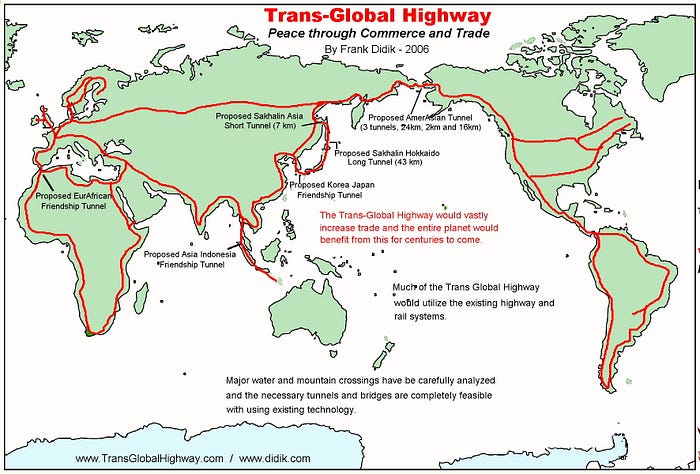
The Trans-Global Highway
The Ultimate Road Trip
The concept of a Trans-Global Highway was proposed by Frank Didik in 2006 as a plan to connect all the globes continents through a series of bridges and tunnels. This further built on the concept of the Cosmopolitan Railway proposed in 1890 by William Gilpin. Whether a rail or a road network, the thought of being able to travel from Patagonia to Scotland or Cape town, would be a great adventure and bring about endless opportunities for tourists and business alike.
However, there is always the reality of cost to consider. As a point of reference, the Channel Tunnel connecting Britain and continental Europe in 1994 cost £9 billion to complete. This is for a length of sub-sea tunnel that is 31 miles in length. To connect Russia with Alaska would take a tunnel 24 miles long. A considerable percentage less than the Channel Tunnel. The costs could be far greater though as there is a lack of infrastructure available due to the remoteness of the Bering Strait. Not insurmountable though.
Besides the cost though their needs to be a willingness on countries to participate in this type of project. Border security becomes an issue whenever the flow of traffic between countries increases. There is the possibility to use existing infrastructure where it is available already. Returning to the Bering Strait crossing, a lot of investment would need to be made to build highways that would suffer severe climatic conditions in winter. Would the US and Russia be willing to invest in this type of infrastructure? Possibly. There is the opportunity for increase in freight if a rail network was part of the proposal as there is trade occurring between countries on both continents.
China has been working towards their plan of one belt and one road plan as part of its efforts to increase economic development around the world. This is tacit way of saying they are looking to get more of their products to global markets faster. Their investment in building roads and rails in developing countries will certainly speed up the pace of development in parts of Africa and Asia that have not the benefit of economic growth or the funds to build huge infrastructure projects. Whether China’s reasons are altruistic or not, the opportunity to connect the globe via series of highways are still appealing.
Other opportunities, besides the obvious trade routes, would be that of new tourism ventures and supporting industries. Trans-global tourism would need to account for the vast distances and climate changes, not that’s anything new, but it would be fantastic to see the changing countryside in a relatively short time. Another consideration would be catering for the increase in electric vehicles and how these are catered for on the journey. Range anxiety is a real issue and it wouldn’t be prudent to start the journey in an electric vehicle in a well-equipped location to find unsuitable facilities in the middle of nowhere. This small issue would be insignificant compared to the experience.
There is one notable outlier in all of this though, Australia. The route that would make the most sense to Australia would be via Indonesia, a country that is an archipelago of 17,504 islands. This would require significant investment to breach all the land masses plus get to the Australian continent. That said, I don’t believe this would be a hindrance if the will existed. Asia is a huge export market for Australia and the added trade route through South East Asia may be beneficial in the long-term. I have also left Antarctica off the list as it would be a little pointless due to the lack of any infrastructure there.
Even taking in to account the multitude of passport checks, different railway gauges, road rules, left or right-hand drive roads and vast distances, those seeking a connected globe should still dare to dream. Big dreams like this take time and investment to become a reality. I am still optimistic that the world could be connected and that a trip across the Bering Strait becomes destination for the average person and not a hardy adventurer. Well done Frank Didik for sowing the seed.
